On the morning of November 9, Mr. Pham Phu Ngoc, Deputy Director of the Hoi An World Cultural Heritage Conservation Center, said that he is coordinating with the functional departments of Da Nang City to continue surveying the ancient ship discovered in the Tan Thanh sea area (Hoi An Tay ward, Da Nang City).
The ancient ship in Hoi An "appears and disappears"
According to Mr. Ngoc, this ship was discovered in 2023 and the authorities have conducted an initial survey. On November 8, after storm No. 13, the ship was once again exposed by waves, its shape appeared more clearly. However, in the evening of the same day, the tide rose, causing the ancient ship to sink deep into the water again. This morning, part of it was exposed but not as clear as yesterday.
"This morning, we are coordinating with the city's functional departments to survey and propose a direction for handling and excavating this ship," said Mr. Ngoc.
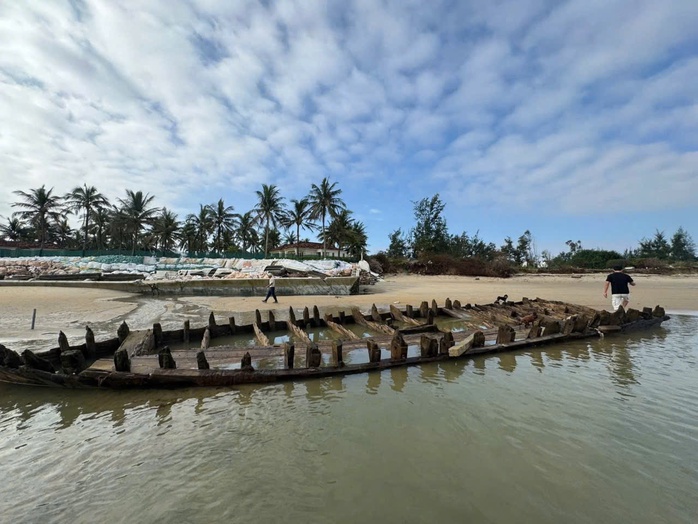
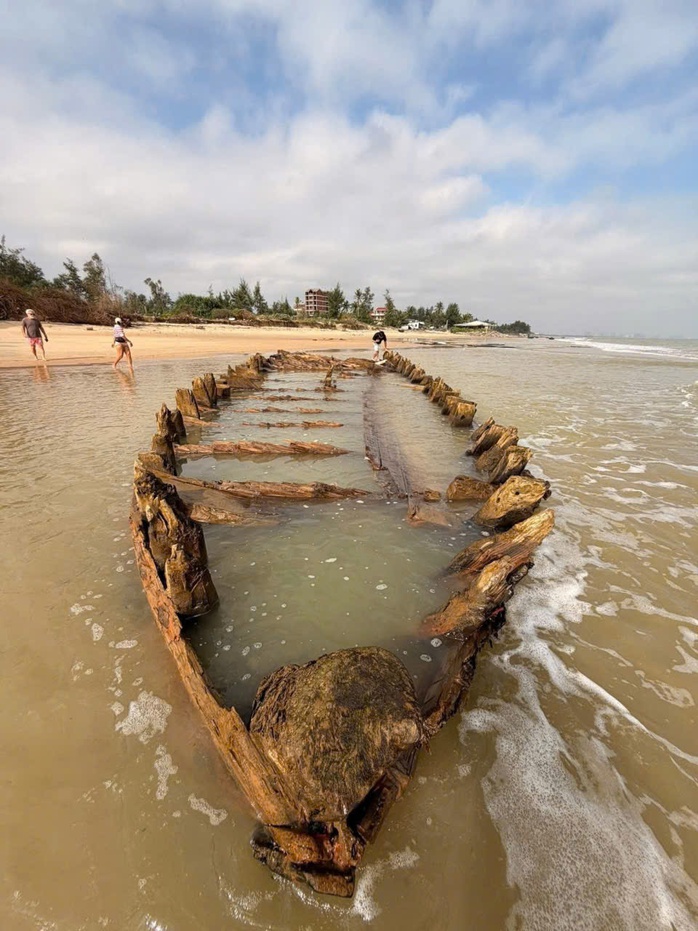
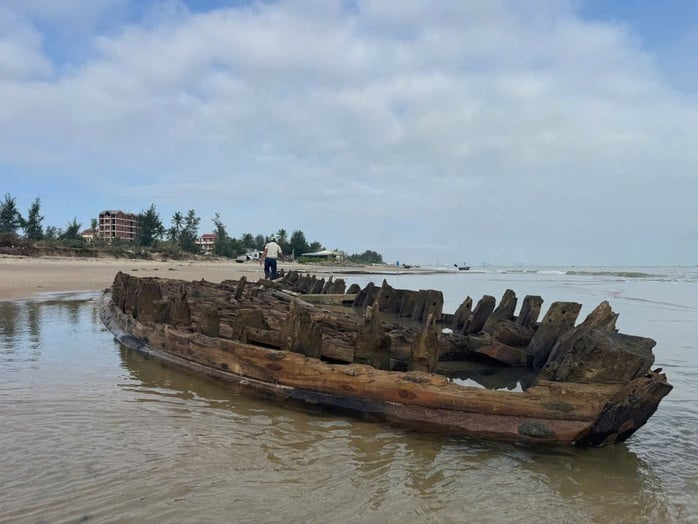
The ancient ship was discovered with a clear shape on November 8 (Photo: Hong Viet)
Previously, in May 2025, the Hoi An World Cultural Heritage Conservation Center initially informed about the survey results of the above ship.
According to the Hoi An World Cultural Heritage Conservation Center, on the morning of December 26, 2023, along the coast of Thinh My block (Hoi An Tay ward), sea waves revealed part of a wooden ship buried in the sea sand. Local residents quickly reported this discovery to the authorities.
Later, a part of the ship's upper structure appeared more clearly, in addition to the many exposed ends, a block (prow block or stern block), some upper sections of the hull and the bolt were also clearly visible.
At this time, the ship's width was measured to be 4.7 m, and its length from the block to the last exposed beam was 16.15 m. Some beams had round holes through the body, and the beams and beams were fixed with iron pins.
Overall, the bars and latches are quite large in size, good quality wood, carefully crafted and firmly drilled.
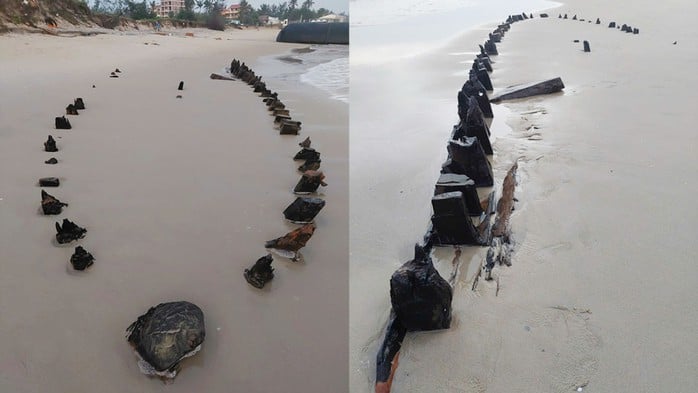
Image of the ancient ship discovered in December 2023 (Photo: Hoi An World Cultural Heritage Conservation Center)
Through interviews, some local residents said that the place where the ship appeared before was a very high slope (sand hill), located next to a main road built during the French colonial period, far from the coast.
This place belongs to the garden land of Mr. Truong Du's family since the French colonial period. Due to the strong erosion of the coastline, encroaching deep into the mainland, the residents had to move to another place. According to some residents, from the current coastline, more than 200 meters away, in the past, when the sea level receded, one could see some undulating lime graves and traces of house foundations...
In recent years, ocean waves have also revealed on the beach many pieces of ceramic bowls and cups of Chinese origin dating from around the 18th - 19th centuries.
At the time of the survey, the entire ship was buried deep under layers of sand and soil due to the waves. Therefore, in order to collect samples for analysis, the survey team carried out professional activities to determine the location of the boat and expose part of the hull.
Possibility that the ancient ships in Hoi An were built in the South Indochina region
Ethnographic and archaeological fieldwork shows that the location where the ship appeared was formerly a coastal sand dune (high sand hill), next to the sand dune was a road built during the French colonial period. Due to sea erosion, only a short section of the road remains, and in the area where the ship appeared, the road has been eroded away without a trace.

Crow
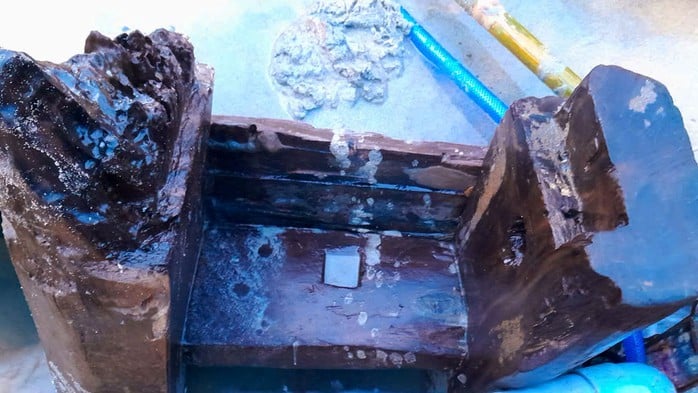
Be, dang and bo row (Photo: Hoi An World Cultural Heritage Conservation Center)
This road is clearly shown on the Tourane map printed in 1905. And so, the road was built at the latest in the late 19th century to before 1905.
Through maps, satellite images from many periods and memories of many local people, on the one hand, it is clear that the trend from the 20th century to the present has been increasingly strong, on the other hand, it also confirms that the location of the old ship was not only deep under the sand dunes, but in 1905 the ship could have been about 700 - 800 m from the water's edge.
And so, whether the ship was sunk or abandoned, the date of sinking or abandonment is likely to be at least several centuries earlier than 1905.
The results of the forensic analysis showed that the ship was made from the following types of wood: The beams were made from Lagerstroemia sp. wood (most likely Lagerstroemia sp.); the planks were made from Hopea sp. wood; the deck and the compartment partitions were made from Pinus sp. wood. Through analysis, the authorities determined that it was highly likely that the ship was built in the South Indochina region.
Initial survey can see that the structure of Cam An boat shows some typical features of traditional Southeast Asian boat structure, along with some typical features of traditional Chinese boat structure.
The Hoi An World Cultural Heritage Conservation Center said that from the findings and initial surveys, the above analysis, comparison and comments show that this ship is an important underwater cultural heritage in Hoi An.
To better understand the values of the boat itself in terms of origin, age, structure and technique, owner, function, etc., it is necessary not only to have a thorough excavation and research project implemented by experts with interdisciplinary coordination, but also an equally important part is the plan and method of managing, preserving and promoting the boat effectively after excavation and research.
Source: https://nld.com.vn/ket-qua-khao-sat-ban-dau-ve-tau-co-o-hoi-an-196251109095643379.htm














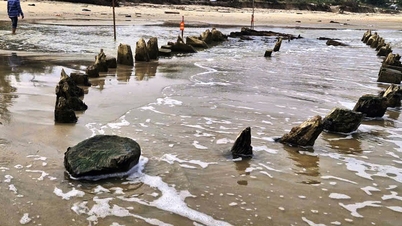























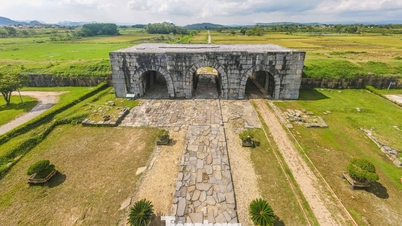



































































Comment (0)